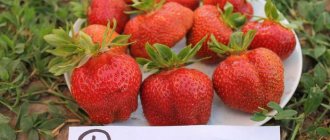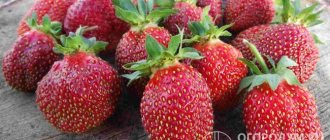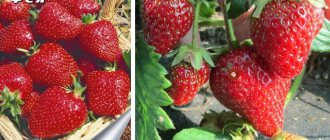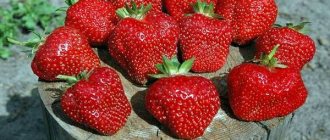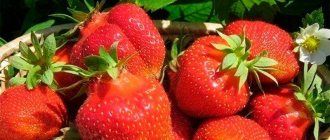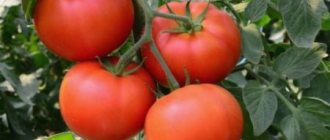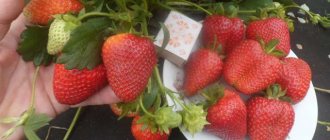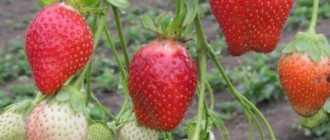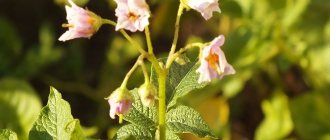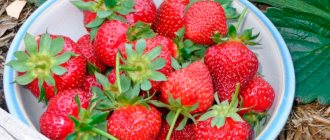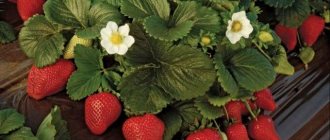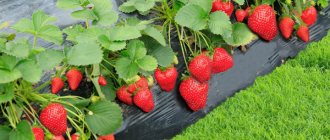The Kent strawberry variety was produced by Canadian breeders in 1970. The variety became available to Russian gardeners only in the 90s. In our country, the berry is popular for its resistance to changeable weather conditions and cold weather. The Kent variety has taken root in the Ural and Siberian beds. Now this species has outlived its usefulness, giving way to remontant varieties in terms of berry size and yield.
Berries
Garden strawberries of the Kent variety produce large, fleshy berries that weigh up to 30 grams. The shape of the fruits is round or heart-shaped, juicy red. A distinctive feature is a tubercle near the neck. Inside the flesh is light red, juicy, dense. They have a pronounced sweet taste. Kent strawberries have a dense structure, so they tolerate transportation and long-term storage well. Entrepreneurs love this view for this reason. It sells itself thanks to its attractive appearance, sweet taste and strawberry smell. These first spring berries are a joy to buy. The fruits can be frozen; they retain their shape well after defrosting. They make excellent jam and preserves.
Due to the weight of the fruits, the flower stalks cannot hold them high. Therefore, the berries often lie on the ground and may begin to rot. Gardeners recommend making devices to support bushes. The strawberry variety Kent produces large fruits only during the first year.
Advantages and disadvantages of the variety
It is impossible to please the taste and aesthetic preferences of every person. Against this background, disputes arise around varieties and their characteristics. Pros and cons can be identified for each type of strawberry. Garden strawberries of the Kent variety are no exception.
Despite the fact that there are more advanced varieties, Kent strawberries have a number of characteristics that attract gardeners:
- Delicious fruits;
- Attractive appearance of berries;
- The berries are resistant to transportation and storage;
- The plant is not afraid of frost and tolerates winter well;
- Takes root on any soil;
- The variety is resistant to most diseases and pests;
- Grows well in the shade;
- Not afraid of moisture, without damaging the berries;
- It grows well even in Siberian conditions.
- The clearance is average, so the area does not become clogged.
Along with this, Kent also has disadvantages, which are the main argument for rejecting this variety:
- The berries are large only in the first year of cultivation, then they become very small.
- Externally, the fruits are not always uniform; they are irregular in shape.
- Thin peduncles lie on the ground, not allowing the berries to ripen equally on all sides.
- The variety is not remontant; it bears fruit only for 1-2 months.
- The yield is small.
Kent strawberries, unfortunately, are outdated and much inferior to modern varieties. Therefore, it is rarely planted. But Kent is very hardy and does not require careful care. Whereas from more advanced varieties you will not get a decent harvest without constant care and good soil. This strawberry is for those who cannot devote much time to their garden and live in harsh climatic conditions.
Description of the Kent variety, its characteristics
Kent - early ripening strawberry, non-repairing. The variety was bred in Canada, in the city of Kentville, back in 1973 on the basis of three different varieties that are resistant to the vagaries of weather and have a good berry taste. After refinement and extensive variety testing, Kent strawberries were registered in Canada in 1981 and began to be actively used by farmers. Almost immediately she began her journey through various countries in America and Europe. In 1990, the variety appeared in Russia. Since it turned out to be undemanding to soil and care, it quickly became popular and was often named among the best early varieties.
Strawberry Kent is distinguished by tall bushes on which numerous flower stalks are formed. They are approximately the same height as the leaves, which are dark green in color. Under the weight of the berries, the peduncles are not supported and fall to the ground, so mulching the beds in order to keep the berries clean is mandatory. This variety produces relatively few whiskers, but they are quite enough for reproduction. In addition to the mustache, dividing the bush or growing seedlings from seeds is used for this purpose.
Unfortunately, even the berries that have not yet grown to their size knock the flower stalks to the ground
The berries ripen early, in the middle zone already at the very beginning of June, fruiting is extended. They are large in size, the average weight is more than 30 g, at the first picking - almost 40 g. However, over time, the berries become very small, the weight can decrease to 12–15 g. The shape is heart-shaped or round-conical, the consistency is very dense, the surface is glossy. The neck is hardly noticeable, often it is not there at all. Fully ripe berries are dark red in color. The seeds are clearly expressed: they have the usual yellow color, but are located superficially. The juice content is high, the pulp is very sweet, with a slight sour taste, the taste is rated as very good. The color of the pulp is red, the aroma is strong. Ripe berries are easily separated from the stalk.
The yield of this variety is not a record, but quite high: with proper care, you can harvest up to 700 g of berries from one bush. The positive point is that the variety bears fruit normally in partial shade, and the taste of the berries does not suffer. During drought, the quality of the berries does not deteriorate, but the yield is significantly reduced. The variety is not afraid of prolonged rains.
The harvest can easily be transported over long distances, and the berries are well stored. Kent strawberries are considered frost-resistant, but if there is no snow cover at temperatures around -10...-15 °C, then without additional shelter the bushes may freeze. Resistance to diseases is above average: for example, the variety is almost not affected by gray rot and powdery mildew, and is weakly affected by strawberry mites. The scourge of this variety is verticillium, and you have to keep a close eye on the possible appearance of signs of this disease.
Video: Kent strawberries in the garden
Landing
Strawberries Kent are planted as seedlings in early spring or autumn. Experienced gardeners recommend planting in the spring, as soon as the snow melts and the ground warms up. This way the sprouts adapt better to new conditions. They are replanted together with a clod of earth so as not to damage the roots. After planting, young plants require careful care:
- Constant watering;
- Removing the tendrils so that the plant can take root better and gain strength;
- Feeding the soil with nutrients;
- Protection from diseases and pests.
When choosing a place to plant Kent strawberries, you should avoid areas where potatoes, tomatoes, and cucumbers previously grew. It is better to prepare the soil in advance: disinfect it with lime and wood ash. Leave it for the winter. And in the spring, dig it up again and add humus. You should not plant Kent in lowlands and places that are poorly ventilated. But too open areas are also undesirable.
Planting process:
- 3 days before planting the sprouts, stop watering.
- Prepare the holes: put a little ash on the bottom.
- Right before planting, the pot with the sprout is watered generously so as not to damage the roots.
- It is important not to damage the roots and place them vertically down.
- The root collar remains above the ground and cannot be sprinkled.
Kent strawberries should be planted at a distance of at least 50 cm from each other, as the bushes will grow. Otherwise, the plants will not have enough space to grow, water and nutrients. Accordingly, the harvest will be poor.
Subtleties of cultivation
Kent strawberries, as a rule, produce the first berries the next year after planting . Young plants bear fruit again in August - September. An important condition for obtaining a good berry harvest is proper and timely care.
Watering . Regular watering, especially during dry periods, is one of the most important components for the successful cultivation of this crop. But you should not over-moisten the soil, as this can provoke fungal infection and reduce the frost-resistant qualities of the variety. In spring, watering is carried out by sprinkling, and with the appearance of the first flowers it is recommended to water the strawberries at the root.
Strawberries kent in the garden plot
Trimming . Like most other varieties of strawberries, Kent produces mustaches, although rather few. In the fall, it is recommended to prune them, leaving 2 strong uterine shoots on each bush for further propagation. At the same time, mow down the old foliage.
Feeding. Throughout the growing season, it is necessary to provide the plant with adequate nutrition. In the spring, fertilizing with nitrogen fertilizers (for example, ammonium nitrate or urea) will be appropriate. In summer and autumn, complex mineral fertilizers will provide the plant with additional nutrients. An alternative to chemicals would be liquid chicken manure, manure, humus, and ash.
Mulching . One of the important care procedures for strawberries is mulching. For this purpose, straw, dry grass, sawdust, compost, and humus are used. The permissible covering height is no more than 6-8 cm. A special material - agrofibre - is also suitable as mulch.
Wintering. In order for strawberry bushes to survive the winter cold without loss, it is necessary to carry out appropriate agrotechnical work. To do this, plants are pruned in the fall, at the same time thinning the beds and removing excess overgrown bushes, and thoroughly loosening the soil. After removing the foliage, the plants are treated with drugs against pests and diseases, and fertilizers are applied.
Kent is a winter-hardy variety, but still in those areas where there is a significant drop in temperature or low snow cover, it is recommended to use a mulch layer of organic materials to prevent plants from freezing. In the spring, when warm weather sets in, the bushes must be immediately freed from mulch, otherwise they may rot.
Ripe berries
Reproduction
There are several ways to propagate strawberries:
• mustache; • divide the bush; • seeds.
For propagation, the mustache that strawberries sprout during the period after flowering is often used. It is best to use the first tendrils that appear in the summer to renew the beds. They are the strongest. The mother bush must be strong and bear the highest quality fruits. 2 tendrils are left on the bush, the rest are cut off. These tendrils are distributed between the rows.
When the first rosettes appear and roots sprout, they are sprinkled with earth and watered abundantly. But they don’t cut it off from the mother bush. You can separate the rosettes a week before transplanting. They are landing at a new place. When 4-5 leaves appear. This should be done in the summer at the end of July so that the sprouts can take root and get stronger. This way they will survive the winter better, and next summer they will bear their first fruits.
Growing and care
Strawberries of the Kent variety are unpretentious. It does not require special care and takes root in almost any soil.
However, in acidic soils the plant will suffer. You should also not plant strawberries of this type on swampy soil and soils with excess lime. In any case, nutrients and fertilizers should be added to the soil. As a preventative measure, you need to disinfect the soil before planting.
For Russian conditions, this garden strawberry is a godsend. She is not afraid of the cold, like most other strawberry varieties. It can be planted under film and harvested earlier. Regarding the growing location, shady and sunny areas are equally suitable.
The process of caring for a plant consists of:
- Timely watering;
- Loosening the soil under the bushes;
- Trimming unnecessary tendrils;
- Fertilizer;
- Weed removal;
- Protection from diseases and pests.
Watering
The strawberry variety Kent can grow in humid conditions. The abundance of water does not affect the taste of the berries. They turn out just as sweet. They ripen on time, as expected. There is no process of root rotting. Despite this, you should not overwater the beds. Berries can rot from water.
You need to water the plant with a watering can or using spray nozzles. Frequency 3 days. The water should be warm. Tap water won't work. This variety should be watered only at the root in summer. You can irrigate from above only in spring. Watering should be accompanied by loosening the soil.
The plant is drought resistant. Can easily tolerate dry periods. This does not affect the condition of the berries. But you shouldn’t forget about watering for a long time.
Description of the strawberry variety Kent
Let's start with a description. Strawberry Kent is a high-yielding, frost-resistant variety bred by Canadian breeders in the 70-80s. Thanks to its winter-hardy qualities, Kent is successfully grown in central and central Russia, as well as in Siberia when using shelter.
Kent strawberries are characterized by the formation of a tall, erect bush with dark green foliage and numerous peduncles. The number of whiskers is insignificant. Kent is classified as a medium-early ripening variety. Berry picking begins in the first ten days of June. The fruiting period is long. It is also possible to get several harvests per season, since young rosettes bear fruit again in August - September. An adult plant is resistant not only to cold, but also to drought.
Strawberry kent closeup
Strawberry care
To protect the beds from weeds and protect Kent from diseases and pests, a special material – mulch – is spread over the soil. It protects the soil from drying out and frost. More often they use pine needles, straw, sawdust or special breathable fabric. Do not use polyethylene.
The mulching process is done when the strawberries fade and the first berries appear. After harvesting, the mulch is removed. Loosen the soil around the bushes to allow oxygen to flow in and excess moisture to evaporate. Wintering will be better if the soil around is dry.
During periods when strawberries do not bloom and there are no berries, the plants need to be fertilized. Fertilizers made from natural ingredients are suitable for this: manure, nettle, compost, etc. Ready-made fertilizers from the store are also suitable.
In spring you need to add nitrogenous substances. In summer and autumn, fertilizers containing potassium and phosphorus are required.
Like all other perennial plants, strawberries need to be prepared for winter. The process of preparing for wintering consists of the following activities:
- Feed the plants with organic fertilizers.
- Trim damaged and wilting leaves.
- Do mulching - cover the bushes
In regions with cold winters, strawberries need to be well covered. Agrofabric, pine needles, straw and other film materials are suitable for this. In the southern areas there is no need to cover Kent. It tolerates frosts down to -20 degrees.
Growing strawberries Kent
From the point of view of agricultural technology, the Kent variety is not difficult; planting and care are similar to those for the crop as a whole. As a rule, rosettes are planted on a new bed when they are ready from the mustache, that is, by the end of summer. At latitudes north of Moscow, this is not the safest time, and the landing is postponed to April - early May. It is also better to divide the bushes in the spring, before flowering begins. The bushes are planted sparsely, at distances of 50 cm from each other: denser planting is undesirable for tall bushes.
Regimes of watering and fertilizing are usual. Before setting berries, the soil is systematically loosened, then mulched with clean material such as straw. In this case, watering is reduced by a third, carried out only at the root and not with the coldest water.
In regions with unstable snow cover and severe frosts, strawberries are covered for the winter. Serious shelter is not required; it is enough to scatter branches of coniferous trees over the garden bed.
Shelter is required only in regions with problems with snow and frost.
Protection from diseases and pests
A valuable feature is that Kent garden strawberries are not susceptible to diseases inherent in other strawberry varieties. At least the leaves don't get sick. But the roots may suffer. Therefore, over-wetting the soil and temperature fluctuations should be avoided. Most often, Kent suffers from gray mold and verticillium. But preventing them will help avoid problems.
To prevent gray rot, it is necessary to carry out preventive spraying with Bordeaux mixture. But this should be done before the flowers appear or after harvesting.
The second disease affects strawberry roots. As a result, the leaves become covered with brown spots. The berries do not grow and dry out. Gardeners who have been growing Kent strawberries for many years advise, for prevention, to put a tablet of gliocladin into the hole before planting. If the plant is already diseased, the damaged leaves are cut off and the remaining parts are sprayed with a fungicide. The best option to eradicate the disease is to burn all diseased plants by the roots.
An excellent way to keep pests out are barriers made of repellent plants: garlic, marigolds and others.
Even though the Kent variety is outdated, it has many advantages. Still popular among experienced gardeners. They love him for his unpretentiousness and ease of care. Kent can grow and bear fruit in almost all regions of Russia. These delicious garden strawberries are one of the first to appear on shelves in the spring. But without proper care and conditions, not a single variety will produce the required harvest. Therefore, the better the growing conditions, the better the harvest will be.
